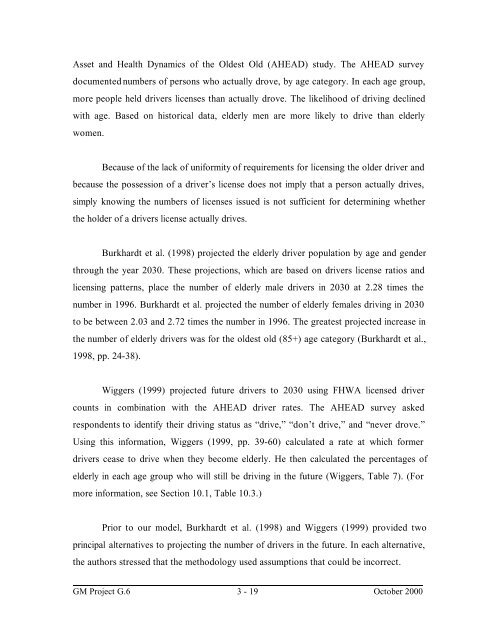Projecting Fatalities in Crashes Involving Older Drivers, 2000-2025
Projecting Fatalities in Crashes Involving Older Drivers, 2000-2025
Projecting Fatalities in Crashes Involving Older Drivers, 2000-2025
Create successful ePaper yourself
Turn your PDF publications into a flip-book with our unique Google optimized e-Paper software.
Asset and Health Dynamics of the Oldest Old (AHEAD) study. The AHEAD survey<br />
documented numbers of persons who actually drove, by age category. In each age group,<br />
more people held drivers licenses than actually drove. The likelihood of driv<strong>in</strong>g decl<strong>in</strong>ed<br />
with age. Based on historical data, elderly men are more likely to drive than elderly<br />
women.<br />
Because of the lack of uniformity of requirements for licens<strong>in</strong>g the older driver and<br />
because the possession of a driver’s license does not imply that a person actually drives,<br />
simply know<strong>in</strong>g the numbers of licenses issued is not sufficient for determ<strong>in</strong><strong>in</strong>g whether<br />
the holder of a drivers license actually drives.<br />
Burkhardt et al. (1998) projected the elderly driver population by age and gender<br />
through the year 2030. These projections, which are based on drivers license ratios and<br />
licens<strong>in</strong>g patterns, place the number of elderly male drivers <strong>in</strong> 2030 at 2.28 times the<br />
number <strong>in</strong> 1996. Burkhardt et al. projected the number of elderly females driv<strong>in</strong>g <strong>in</strong> 2030<br />
to be between 2.03 and 2.72 times the number <strong>in</strong> 1996. The greatest projected <strong>in</strong>crease <strong>in</strong><br />
the number of elderly drivers was for the oldest old (85+) age category (Burkhardt et al.,<br />
1998, pp. 24-38).<br />
Wiggers (1999) projected future drivers to 2030 us<strong>in</strong>g FHWA licensed driver<br />
counts <strong>in</strong> comb<strong>in</strong>ation with the AHEAD driver rates. The AHEAD survey asked<br />
respondents to identify their driv<strong>in</strong>g status as “drive,” “don’t drive,” and “never drove.”<br />
Us<strong>in</strong>g this <strong>in</strong>formation, Wiggers (1999, pp. 39-60) calculated a rate at which former<br />
drivers cease to drive when they become elderly. He then calculated the percentages of<br />
elderly <strong>in</strong> each age group who will still be driv<strong>in</strong>g <strong>in</strong> the future (Wiggers, Table 7). (For<br />
more <strong>in</strong>formation, see Section 10.1, Table 10.3.)<br />
Prior to our model, Burkhardt et al. (1998) and Wiggers (1999) provided two<br />
pr<strong>in</strong>cipal alternatives to project<strong>in</strong>g the number of drivers <strong>in</strong> the future. In each alternative,<br />
the authors stressed that the methodology used assumptions that could be <strong>in</strong>correct.<br />
GM Project G.6 3 - 19 October <strong>2000</strong>
















